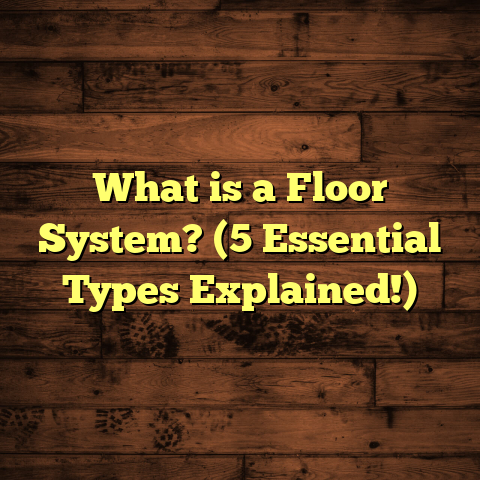What is Wood Flooring Made Of? (5 Key Types Revealed!)
The Versatility of Wood Flooring
I’ve always been fascinated by how versatile wood flooring can be. Over the years, I’ve had the chance to work on a wide range of flooring projects—everything from rustic cabins nestled in the forests of Vermont to ultra-modern city lofts in Chicago. Each space comes with its own unique demands, styles, and budgets, yet wood flooring consistently proves to be an adaptable solution.
Why? Because wood flooring isn’t just one product; it’s a category that covers multiple materials and construction methods. Each type of wood floor offers different aesthetics, durability levels, installation techniques, and care requirements. This versatility allows wood floors to fit almost any home design or lifestyle.
Maybe you’re curious about what wood floors are really made of or how to decide which type fits your needs best. Or maybe you’re just wondering why some floors cost way more than others even though they all look like “wood.” I’ve been in the flooring business for well over a decade now, and I want to share everything I’ve learned about the materials behind wood flooring, including some insider tips, cost breakdowns, and real-world stories.
Let’s start by answering a simple but essential question:
What is Wood Flooring Made Of?
When people say “wood flooring,” they often picture long wooden planks spread out across a room. But the truth is there’s much more variety beneath that surface.
Wood flooring generally falls into two main categories:
- Solid wood flooring: Made from a single piece of natural wood.
- Engineered wood flooring: Constructed from multiple layers of wood or wood products glued together.
Within these categories are several specific types of flooring. Each has its own composition, manufacturing process, advantages, drawbacks, and price point.
Here’s the big picture:
| Flooring Type | Composition | Thickness (Typical) | Cost Range (Materials) | Where It Works Best |
|---|---|---|---|---|
| Solid Hardwood | Single solid hardwood plank | ¾ inch (19 mm) | $6 – $12 per sq ft | Traditional homes, refinishing possible |
| Engineered Hardwood | Hardwood veneer + plywood/HDF core | ⅜ – ½ inch (9-12 mm) | $4 – $10 per sq ft | Moisture-prone areas, concrete subfloors |
| Laminate Flooring | High-res image + fiberboard core | 6 – 12 mm | $1.50 – $5 per sq ft | Budget-conscious installs, rental properties |
| Bamboo Flooring | Compressed bamboo strips | ½ – ¾ inch | $3 – $8 per sq ft | Eco-friendly designs, humid climates |
| Reclaimed Wood Flooring | Salvaged aged hardwood | Varies (~¾ inch) | $5 – $15+ per sq ft | Unique character floors, historic homes |
I’ll go deep into each type soon, but first I want to share some background about why these materials matter so much.
Why Does the Material Behind Wood Flooring Matter?
When you pick out a floor, it’s easy to focus on how it looks—color, grain pattern, plank width—but the material makeup impacts almost everything else:
- Durability: How long will the floor last before it shows wear? Can it be sanded and refinished?
- Installation: Can you DIY it? Does it require special subfloors or adhesives?
- Maintenance: How much care does it need? Is it resistant to moisture or scratches?
- Cost: How much will materials and labor add up to?
- Environmental impact: How sustainable is the material source?
Knowing what your floor is made of helps you make smarter choices for your lifestyle and budget.
1. Solid Hardwood: The Classic Choice
If you’ve ever walked into an old historic home or luxury hotel lobby and admired the rich wooden floor beneath your feet, chances are you were looking at solid hardwood.
What Solid Hardwood is Made Of
Solid hardwood flooring is crafted from a single piece of lumber cut directly from a hardwood tree. Some common species include:
- Oak (red and white): Most common in U.S. homes.
- Maple: Known for its smooth grain and lighter color.
- Cherry: Has a deep reddish hue that darkens with age.
- Walnut: Dark brown with distinctive grain patterns.
- Hickory: Very hard and durable with strong grain contrasts.
These boards are typically ¾ inch (19 mm) thick and come in widths from around 2 ¼ inches up to 5 or 6 inches wide. Some custom options go even wider for statement floors.
How It’s Made
Manufacturers mill the logs into planks using specialized saws called gang saws or band saws. After cutting, the planks are dried in kilns to reduce moisture content to about 6-8%—this helps prevent warping once installed.
Then the surface is planed smooth and sometimes prefinished with stains or sealants before shipment.
Why Solid Hardwood?
Because it’s one solid piece of wood through and through, you can sand and refinish this type many times—often up to 10 or more during its lifetime. This means if your floor gets scratched or worn after decades of use, you can restore its beauty instead of replacing it.
Real Numbers & Costs
In my projects across the Midwest and East Coast, solid hardwood material costs typically range:
- Lower-end domestic woods like red oak: $6 to $8 per square foot
- Higher-end species like walnut or cherry: $10 to $12 per square foot
Installation usually costs an additional $4 to $8 per square foot depending on complexity. So for a standard 1,000 square foot room, expect total costs roughly between $10,000 and $18,000.
Installation Timeframes
For a room that size, installation plus sanding and finishing typically takes about 3 to 5 days. This includes acclimation time where the planks sit in your home for a few days before installation to adjust to temperature and humidity.
Personal Story: The Victorian Parlor
I once worked on an 1890s Victorian home where the owners wanted an authentic feel matching the era. We sourced custom-milled white oak from Pennsylvania mills within a 200-mile radius to keep it local and sustainable. The boards were wider than usual at 4 inches to match original floors found in historic photos.
The project took just under a week but the results stunned everyone—the warmth and durability of solid hardwood made that parlor feel like stepping back in time.
2. Engineered Hardwood: Layered for Stability
Engineered hardwood is one of those clever innovations that changed how we use wood flooring indoors.
What Engineered Hardwood is Made Of
This floor type consists of several layers glued together:
- Top layer: A thin veneer of real hardwood (usually between 2mm to 6mm thick)
- Core layers: Multiple layers of plywood or high-density fiberboard (HDF), stacked crosswise for strength
- Backing layer: A thin plywood layer that stabilizes the board
This multi-layer construction provides dimensional stability that solid hardwood lacks.
Why Does This Matter?
Solid hardwood expands and contracts with changes in humidity and temperature—sometimes causing warping or gaps. Engineered hardwood’s cross-layered core counters these movements by balancing tension forces, making it less prone to problems.
This makes engineered floors ideal for:
- Basements where moisture is a concern
- Over concrete slabs
- Rooms with radiant heating systems
Thickness & Dimensions
Engineered hardwood planks vary in thickness from about ⅜ inch (9mm) up to around ½ inch (12mm). The top veneer thickness affects how many times they can be sanded—thicker veneer means more refinishing cycles possible.
Cost Breakdown
Material costs for engineered hardwood usually run:
- Basic domestic veneers: $4-$6 per square foot
- Premium imported woods or thicker veneers: $7-$10 per square foot
Installation costs hover around $4-$8 per square foot depending on subfloor prep and method used (glue down or floating).
Installation Details
Engineered hardwood can be installed using methods like:
- Floating floor (click-lock system)
- Glue-down over concrete or plywood
- Nail-down in some cases over plywood subfloors
Installation time is often quicker than solid hardwood because sanding after installation might not be necessary if prefinished boards are used.
Case Study: Miami Condo Project
In Miami’s humid climate, I installed engineered hickory flooring in a new condo on the third floor of a high-rise. The building codes required moisture-resistant floors due to sea-level proximity. Engineered wood’s moisture stability meant no warping after two years despite constant humidity swings.
3. Laminate Flooring: A Practical Alternative
Laminate flooring has gained massive popularity because it looks like wood but costs less and is easier to install.
What Laminate Flooring is Made Of
Unlike solid or engineered hardwood, laminate floors have no real wood on top. Instead they consist of four layers:
- Wear Layer: Tough clear resin layer that protects against scratches and stains.
- Design Layer: High-resolution photographic image replicating wood grain.
- Core Layer: Typically made from melamine resin or fiberboard that adds structural stability.
- Backing Layer: Moisture-resistant underside that prevents warping.
Thickness & Size
Most laminate planks range from 6mm up to about 12mm thick. They’re designed with interlocking edges making them perfect for floating installations without glue or nails.
Why Choose Laminate?
Laminate is extremely durable against dents and scratches compared to softer woods like pine or cherry. It’s great for households with kids or pets on a tight budget.
Cost Breakdown
Material costs typically range:
- Basic laminates: $1.50 – $3 per square foot
- Higher-end laminated planks with textured finishes: $3 – $5 per square foot
Installation by professionals adds roughly $2 – $4 per square foot depending on complexity.
Maintenance & Lifespan
Laminate floors don’t sand well because the design layer is printed paper under resin coating. When worn out (usually after 10-20 years), replacement is required instead of refinishing.
They resist stains well but can’t handle standing water—moisture can cause swelling quickly.
Personal Experience: Rental Property Floors
I installed laminate flooring in several rental units where tenants caused heavy wear on surfaces. The floors held up surprisingly well for about five years before needing replacement—much longer than vinyl alternatives we tried before.
4. Bamboo Flooring: The Grass That Acts Like Wood
Bamboo flooring offers an interesting alternative since it’s technically grass but behaves much like hardwood once processed.
How Bamboo Floors Are Made
The process involves:
- Harvesting mature bamboo stalks (usually at 5-7 years old)
- Cutting into thin strips
- Boiling and drying strips
- Gluing strips together under heat and pressure to form dense planks
Two main styles exist:
- Strand-woven bamboo: Strips shredded and compressed—extremely hard.
- Horizontal/Vertical bamboo: Arranged flat or on edge for different grain looks.
Thickness & Durability
Bamboo planks usually measure between ½ inch (12 mm) to ¾ inch (19 mm) thick. Strand-woven bamboo can be up to three times harder than red oak according to Janka hardness tests—a standard measure of wood hardness used in our industry.
Environmental Benefits
Bamboo regenerates in just 3–5 years compared to decades for hardwood trees. This rapid growth makes it a popular choice for eco-conscious homeowners.
Costs & Availability
Bamboo flooring ranges roughly:
- $3 – $5 per square foot for horizontal/vertical styles
- $5 – $8 per square foot for strand-woven premium types
It’s widely available in North America through specialty flooring suppliers and big-box stores alike.
Installation Insights
Bamboo can be installed similar to hardwood—nail down over plywood or glue down over concrete—or as floating floors with click systems. It’s sensitive to moisture so acclimation before installation is critical.
My Take: Portland Eco-Friendly Homes
Portland has embraced bamboo flooring as part of sustainable building trends. I helped install strand-woven bamboo in several new builds there—the owners loved how dense yet beautiful the floors were plus the low environmental impact.
5. Reclaimed Wood Flooring: History Beneath Your Feet
Reclaimed wood flooring is one of my favorite options when clients want character that new wood just can’t replicate.
What Reclaimed Wood Is Made Of
This involves salvaging old wood from barns, factories, warehouses—sometimes decades or even centuries old—and repurposing it as flooring planks.
The species vary but often include:
- Chestnut
- Oak
- Pine
- Douglas fir
These boards are usually around ¾ inch thick but may vary due to their age and origin.
Why Reclaimed Wood?
Each plank tells a story through nail holes, weathered textures, faded paint spots, and unique grain patterns—something factory-milled boards lack. Plus recycling old wood reduces landfill waste and saves forests.
Challenges & Costs
Working with reclaimed wood requires extra prep work like:
- Removing nails or metal debris
- Flattening warped boards
- Stabilizing boards with fillers or backing layers
Costs vary widely due to sourcing difficulty—from about $5 per sq ft for common reclaimed pine up to $15+ for rare historic woods like old-growth chestnut.
Installation & Maintenance Tips
Reclaimed floors usually require professional installation because unevenness can cause issues with nailing or gluing down planks. Once installed, they need care similar to solid hardwood including regular cleaning and occasional refinishing.
Story From Upstate New York
One memorable job involved installing reclaimed chestnut wood from an old mill near Albany in a loft conversion project. The weathered texture gave the space intense character but took twice as long to prep due to embedded nails from old construction!
Comparing Wood Flooring Types Side-by-Side
Choosing between these five types depends on your priorities:
| Feature | Solid Hardwood | Engineered Hardwood | Laminate | Bamboo | Reclaimed Wood |
|---|---|---|---|---|---|
| Real Wood On Surface | Yes | Yes | No | Yes | Yes |
| Can Be Sanded/Refinished | Many times | Few times (veneer thickness dependent) | No | Few times | Many times |
| Moisture Resistance | Low | Moderate | Moderate | Moderate | Low |
| Installation | Nail/Glue Down | Floating/Glue Down/Nail | Floating | Floating/Nail/Glue | Nail/Glue Down |
| Average Cost /sq ft | $6-$12 + install | $4-$10 + install | $1.50-$5 + install | $3-$8 + install | $5-$15 + install |
| Lifespan | 50+ years | 20+ years | 10-20 years | 20+ years | 50+ years |
| Sustainability | Depends on species/sourcing | Often uses sustainable cores | Manufactured product with synthetic layers | Highly sustainable | Recycled material |
Maintenance Tips for Wood Floors I’ve Learned Over Time
No matter which type you choose, proper care makes a big difference in how long your floors last:
- Dust or vacuum regularly using soft brush heads.
- Wipe up spills immediately to prevent stains or warping.
- Use felt pads under furniture legs.
- Avoid harsh chemicals; use cleaners designed for your specific floor type.
- Humidity control inside homes helps prevent expansion/contraction issues.
For solid and reclaimed hardwoods, sanding/refinishing every decade or so keeps them looking fresh. Engineered floors benefit from gentle cleaning but avoid sanding too often since veneers are thin.
Wrapping Up My Thoughts on Wood Flooring Materials
Wood flooring comes in many forms—from solid planks cut straight from trees to clever layers engineered for stability; from budget-friendly laminates mimicking wood looks to eco-friendly bamboo grass; and even salvaged historic timber full of character.
Understanding what your floor is made of helps you pick something that fits your lifestyle, budget, and aesthetic goals perfectly. Whether you want something that lasts generations or something affordable with good look and feel for now, there’s a wood floor out there that fits just right.
If you want help estimating costs based on your location or project size, tools like FloorTally offer detailed budgeting help incorporating local labor rates and material prices so you get accurate numbers upfront without surprises later on.
Feel free to ask me any questions about choosing the right floor—after all, I’ve walked thousands of miles on these surfaces!
If you want me to expand any section further with more technical details, installation guides, environmental impact data, or real project case studies with numbers specific to certain regions let me know!





